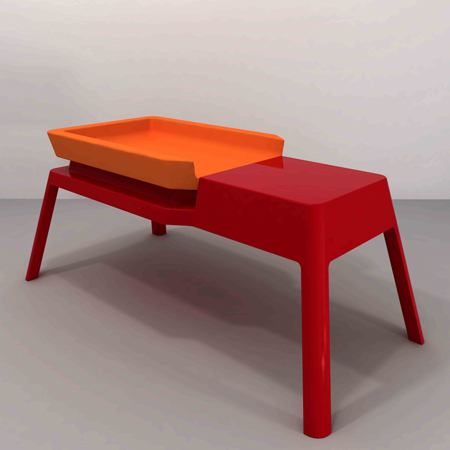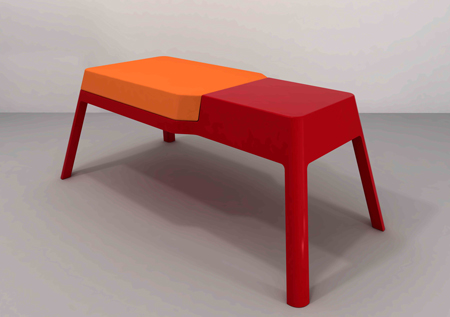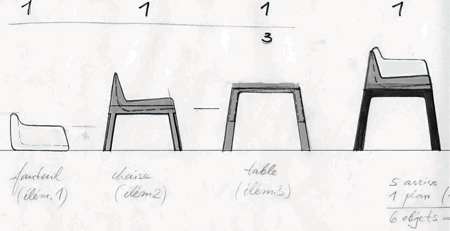
Long Low Hygiene Table and Evoluntionary Chair by Studio Design Rafaschieri
French designers Frank & Stanimira Rafaschieri have designed two prototype pieces of nursery furniture that adapt to children's changing needs as they grow.

The Low Long Hygiene Table (above and top) reduces the risk of injury from falling off a traditional changing table. It can be used as a table or bench when the child is too old to need nappies changing.

The Evolutionary Chair (above and below) starts out as a high-chair and breaks down into a small chair and table when the child is old enough to walk.

Both designs are injection moulded from polypropylene.

The following information is from Studio Design Rafaschieri (they don't have a website yet - we'll put a link up when they do):
--
CHILDREN’S FURNITURE: EVOLUTIONARY CHAIR AND LOW LONG HYGIENE TABLE
Summary
Children’s furniture is intended for being used in child-related everyday activities and manipulations: meals, hygiene and games. The furniture’s design principle contributes to adapting more adequately the height of the seat to the growing child thus lowering the risk and the gravity of a possible fall. An additional asset of the unit is the durability of its components, which can be used either en bloc or separately to safely contain and entertain the child.
The underlying concept takes account of and integrates the child’s ability to progressively find both independence and security in his movements and is conducive to the behaviour of minimum risk, which for the child starts with learning about the closest environment and controlling his bodily movements.
Contestable points of a highchair
Traditionally one uses a children’s highchair equipped with a tray for meals to feed the child, putting the highchair near the dining table for adults. This type of chair is of excessive height for the small child and requires therefore additional safety accessories to protect the child against unintentional fall (safety harness or straps, etc.). In addition, safety has a surcharge and is not a selling point. Most of these articles are sold separately. The risk of falling from neglect is important.
Domestic accidents with children related to the use of furniture or a childcare article have raised the question of improper use of children’s accessories and furniture with unadaptable (dangerous for children) height as the main cause for unintentional fall from big height. According to statistical data falling from a children’s highchair is the most common cause for cranial traumatism among small children (bearing the risk of irreversible implications).
The evolutionary chair
The evolutionary chair includes a rehaussor, a small chair and a low table. The components of the evolutionary chair combine and pile on top of each other in order to propose eight possible combinations that can be used in different context, including four different heights of the seat. The system of stacking makes it possible to easily adapt furniture to the various situations of domestic life according to the practical needs of the user. This group of furniture, which is easy to dissemble and assemble in one article of furniture, is intended for being used from the age of 6-8 months to 5-6 years of the child.

The rehaussor is a seat with armrests equipped with an in-built and removable safety feature. When put directly on the floor it is used to assist and make safe the baby up to twelve months of age when sitting (supported by pillows). With the evolution of needs over time it might also be fixed upon the small chair by means of its outer profile, which has an identical ergonomic form with the curve of the seat and the back. The seat is a hull covered with compressed thermo foam.

The small chair is suitable for children who are already able to walk. The child could sit by himself or be helped by an adult. In combination with the low table, with or without the rehaussor, the evolutionary chair can be used in a variety of configurations daily. The material used for the manufacture of the components of the chair is polypropylene injected.

The low table can be used as a table for meals, games and other activities of the child; it can be also used as a base for the mounting of the small chair and the rehaussor. By its low height, its stable form and the ergonomics of the base, the evolutionary chair makes it possible to ensure maximum safety for everyday use.

Contestable points of a changing table
To change diapers of a newborn, one traditionally uses a changing table or a cabinet on which a mattress is fixed (in some cases without a mattress). Placed at an average height of 90 cm the child runs a risk of falling unintentionally. Note that the fall becomes dangerous as soon as its height exceeds the height of the child.
Generally one places the changing table so that it has at least two protected sides, in a corner of the room for example. The choice of location is important but it is often done according to space available and not for security reasons. The bathroom is a place preferred for practical reasons, but if the child falls from such a height the consequences would be all the more serious, since in his fall it is likely to run up against hard surfaces (edge of the bath-tub or the wash-hand basin, tiling of the floor).
Used several times a day, the existing (conventional) furniture multiplies the risk of an accident. The adult who takes care of the child’s hygiene is standing and able to move away looking for something. The falls generally occur when the child is left alone. Some conventional furniture intended for hygiene activities (diaper changing) is only used for a short period of time and quickly becomes obsolete and useless (taking a lot of space), as it cannot grow with the children’s needs and interests as they develop. Their use is dangerous as soon as the child starts to move and can topple over and fall (for the lack of enough space).
Low long hygiene table
This long table, the height of which equals the height of a standard adult’s chair (45 cm) is intended to the baby’s/child’s hygiene. It will reduce the severity of a possible fall in the daily diaper changes of the child. It includes a component with a flat surface on the one side and upturned edges on the other side in the form of a mattress where hygiene activities are effected; a base on four feet specially designed to integrate the mattress and a seat making it possible for the adult to sit down to carry out the change.
The unit height, identical in both positions of the mattress (both faces can be used), is relatively low, i.e. not exceeding a baby’s height, safe and enables the use of the furniture by the growing child who can go up and down by himself to be changed, accompanied by the adult.
The emotional exchange between the child and the adult runs in a secure environment because there is no gap between them. The formal continuity of the two functional components, which form a flat surface of furniture, allows the child to always have enough space to grow.
The reversible mattress is fixed to the seat using clasps located in the two opposite ends of the internal vertical wall of the seat along the dividing line between the two components. Depending on the particular modes of manufacture, the hull of the changing platform is covered with compressed thermo foam with a finishing fabric layer and can vary from one model to another. The two components of the furniture lie in one surface with unchangeable height regardless of the changing platform position. The material used for the manufacture of the furniture is polypropylene injected.
The design of this furniture allows a durable use from the child’s birth to approximately the age of 2-3 years (as long as the child needs diaper changing). Then, in a different configuration it can be used as an auxiliary table/seat.